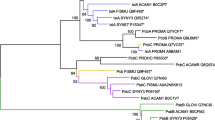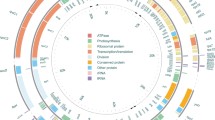Abstract.
The light-harvesting complexes (LHCs) are a superfamily of chlorophyll-binding proteins present in all photosynthetic eukaryotes. The Lhc genes are nuclear-encoded, yet the pigment–protein complexes are localized to the thylakoid membrane and provide a marker to follow the evolutionary paths of plastids with different pigmentation. The LHCs are divided into the chlorophyll a/b-binding proteins of the green algae, euglenoids, and higher plants and the chlorophyll a/c-binding proteins of various algal taxa. This work examines the phylogenetic position of the LHCs from three additional taxa: the rhodophytes, the cryptophytes, and the chlorarachniophytes. Phylogenetic analysis of the LHC sequences provides strong statistical support for the clustering of the rhodophyte and cryptomonad LHC sequences within the chlorophyll a/c-binding protein lineage, which includes the fucoxanthin–chlorophyll proteins (FCP) of the heterokonts and the intrinsic peridinin–chlorophyll proteins (iPCP) of the dinoflagellates. These associations suggest that plastids from the heterokonts, haptophytes, cryptomonads, and the dinoflagellate, Amphidinium, evolved from a red algal-like ancestor. The Chlorarachnion LHC is part of the chlorophyll a/b-binding protein assemblage, consistent with pigmentation, providing further evidence that its plastid evolved from a green algal secondary endosymbiosis. The Chlorarachnion LHC sequences cluster with the green algal LHCs that are predominantly associated with photosystem II (LHCII). This suggests that the green algal endosymbiont that evolved into the Chlorarachnion plastid was acquired following the emergence of distinct LHCI and LHCII complexes.
Similar content being viewed by others
Author information
Authors and Affiliations
Additional information
Received: 25 February 1998 / Accepted: 13 May 1998
Rights and permissions
About this article
Cite this article
Durnford, D., Deane, J., Tan, S. et al. A Phylogenetic Assessment of the Eukaryotic Light-Harvesting Antenna Proteins, with Implications for Plastid Evolution. J Mol Evol 48, 59–68 (1999). https://doi.org/10.1007/PL00006445
Issue Date:
DOI: https://doi.org/10.1007/PL00006445




